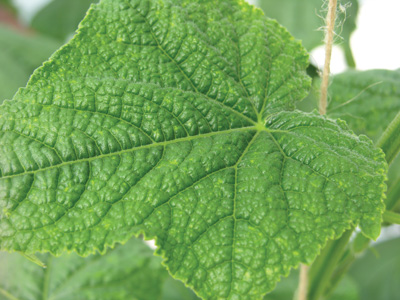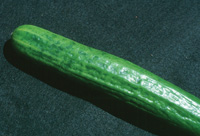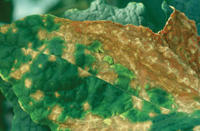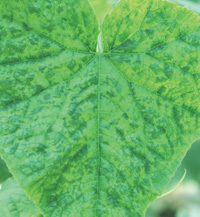
Features
Crop Protection
Inputs
Greenhouse Grower notes: Common cucumber viruses
August 31, 2010 By Gillian Ferguson
Two relatively common yet very different viruses that can infect
cucumbers include Cucumber mosaic virus (CMV) and Melon necrotic spot
virus (MNSV)
Two relatively common yet very different viruses that can infect cucumbers include Cucumber mosaic virus (CMV) and Melon necrotic spot virus (MNSV). The objective of this article is to provide some notes on the transmission and management of these two virus diseases.
 |
|
| Early leaf symptoms of Melon necrotic spot virus in cucumber. PHOTOS COURTESY GILLIAN FERGUSON, OMAFRA Advertisement
|
Cucumber mosaic virus: Cucumber beetles and over 60 species of aphids (immature and mature) can pick up CMV from infected plants while feeding. Some of the most efficient aphid vectors are the cotton aphid (Aphis gossypii) and the green peach aphid (Myzus persicae).
The virus can be picked up in less than one minute of feeding and inoculated into a healthy plant in less than one minute also. Generally, cucumber beetles or winged aphids remain infectious for less than four hours after picking up the virus. The more feeding punctures the insects make, the more rapidly they lose their ability to transmit the virus. Fortunately, females carrying the virus do not transmit it to their young.
The virus spreads systemically within the plant, and once a plant becomes infected, subsequent infection of other plants can be spread by plant sap on knives and hands. The virus is rarely transmitted by seeds.
Symptoms usually appear within five days of infection in young plants, and within 14 days in older plants. Symptoms often appear first on the young shoots and are reported to develop faster at higher temperatures (26 to 32℃) than at lower temperatures. Short days and low light conditions can also worsen symptoms.
 |
|
| Cucumber fruit infected with Cucumber mosaic virus.
|
Plant hosts of CMV – Cucumber mosaic virus occurs worldwide and has an extensive host range. It can infect about 800 plant species and a number of these are woody hosts such as grape and various species of Prunus, eg. peaches. Crop hosts include tomato, pepper, eggplant, corn, onion, watercress, beans, lettuce, carrots, celery, clover, spinach, sugar beet, etc. Ornamental hosts include narcissus, gladiolus, impatiens, petunia, phlox, rudbeckia, etc. Weed hosts include purslane, ragweed, black nightshade, hogweed, shepherd’s purse, starwort, etc.
Management of CMV – There is no known cure for this virus. At first sign of an infection, symptomatic plants and a few adjacent non-symptomatic ones should be removed and properly disposed of. Those rows with infected plants should be marked and worked last in order to minimize spread of the virus. Dipping of gloved hands in a disinfectant either between plants or at least at the end of rows would also assist in minimizing spread of the virus.
The insect vectors should be suppressed using appropriate controls. Some non-chemical options are exclusion of insect vectors by screening of vents, and removal of any potential plant hosts for the virus and insects from the area surrounding the greenhouse. Ideally, it would be best to use a resistant cultivar.
MELON NECROTIC SPOT VIRUS
■ This virus is transmitted by a water-loving soil-borne fungus called Olpidium sp., which is similar in biology to Pythium sp. While Olpidium spores are still in the soil, the virus attaches itself to the outer covering of the fungus.
 |
|
| Advanced leaf symptoms of Melon necrotic spot virus in cucumber.
|
When the fungus penetrates the root of a healthy plant, it carries the virus into the plant with it. Once the virus is in the plant, it can be transmitted to other plants mechanically, such as during pruning and harvesting. This virus is very stable and can remain in the soil for up to several years.
Symptoms of MNSV start off as tiny, clear, round spots, usually on the youngest leaves. These spots gradually enlarge, becoming brown in the centres. Eventually, the brown spots expand to the extent that they overlap and resemble those of a fungal disease such as anthracnose.
 |
|
| Cucumber leaf infected with Cucumber mosaic virus.
|
Management of MNSV – Once a plant becomes infected with MNSV, as with other viruses, it will remain so for the rest of its life. The management approach for this virus is very similar to that of CMV – i.e., removing and disposing of infected plants, preventing spread of infected plant sap by disinfecting pruning tools, sterilizing root media, and carrying out management strategies similar to those for Pythium for the Olpidium vector. In this regard, we need to ensure that the irrigation water is clean, and if recirculated, that the disinfection system is working efficiently.
IMPLICATIONS FOR SANITATION BETWEEN CROPS
■ Given that these virus diseases are systemic within the plant, it is possible that viral particles could seep into the growing medium from damaged roots. However, heat treatment of the growing media could eradicate the virus. The minimum temperature (when maintained for a minimum of 10 minutes) that will kill CMV is about 70℃, and about 60℃ for MNSV. Therefore, steaming of media that held infected plants should eliminate the virus provided that the appropriate temperature is attained and maintained within the medium for the recommended period of time.
Infectivity of CMV in sap at room temperature is retained for three to six days, and for MNSV for nine to 32 days. Such survival requires that a thorough general cleanup and disinfection be implemented to reduce chances of carryover to the following crop. ■
Gillian Ferguson is the greenhouse vegetable IPM specialist
with the Ontario Ministry of Agriculture, Food and Rural Affairs in
Harrow, Ontario.
• Gillian.Ferguson@Ontario.ca
Print this page